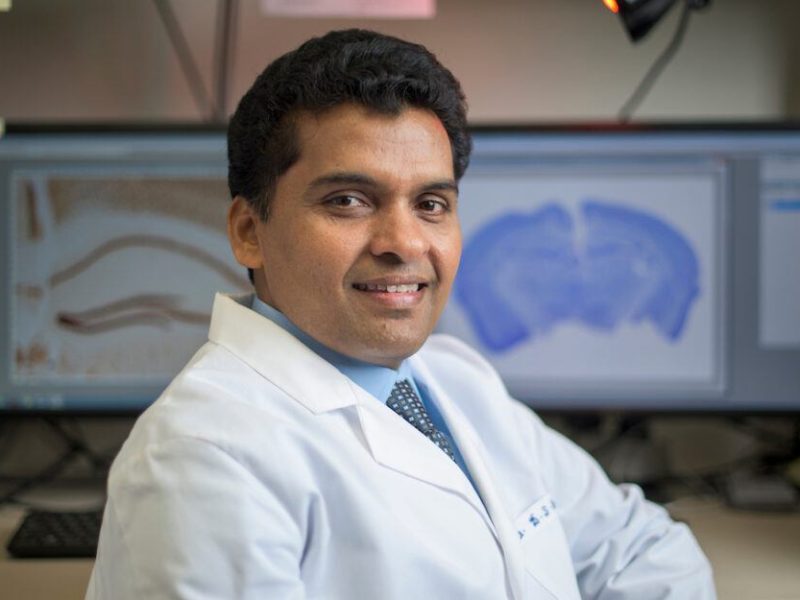Texas A&M Researcher Helps Develop First Treatment For Rare Type Of Refractory Epilepsy

After completing his pharmacy degree at Kakatiya University in Warangal and Ph.D. at Panjab University in Chandigarh, India, D. Samba Reddy, now a Regents Professor in the Department of Neuroscience and Experimental Therapeutics at Texas A&M University School of Medicine, was embarking on a career teaching and researching at one of India’s leading universities. “I was happily settled,” Reddy recalled.
That is, until a letter from the U.S. National Institutes of Health (NIH) arrived in his mailbox in 1998 and changed his career trajectory forever. Dr. Michael Rogawski, one of the top scientists at the NIH, had invited Reddy to his lab as a visiting scientist.
Reddy had never heard of the NIH, so he reached out to his Ph.D. mentor S.K. Kulkarni for advice. His mentor told him the best research happens at the NIH, and that he should take advantage of the opportunity. , Reddy decided to go to the NIH and stay for a year or two. That was nearly 24 years ago.
Today, Reddy is a Regents professor of Neuroscience and Experimental Therapeutics, Engineering Medicine, Biomedical Engineering and Veterinary Integrative Biosciences at Texas A&M University. He is the founding director of Texas A&M Institute of Pharmacology and Neurotherapeutics. His research focuses on pharmaceutical therapies for epilepsy, and he has spent much of his career studying ganaxolone, a synthetic neurosteroid with potential to treat specific kinds of epilepsy. Reddy’s body of research on ganaxolone showed the compound was successful, allowing ganaxolone to be tested in patients during clinical trials.
In March 2022, the U.S. Food and Drug Administration (FDA) approved ganaxolone to treat CDKL5-deficient epilepsy, a rare type of refractory epilepsy caused by mutations in the CDLK5 gene. Ganaxolone is the first drug to be approved to treat this condition, earning it a first-in-class designation.
“When I packed my two bags to come to the United States from India, little did I know that I would be part of the process of developing a drug that can be helpful to patients worldwide,” Reddy said. “It was just the beginning.”
Forging The Foundation Of Neurosteroids
Reddy has spent his career studying neurosteroids, which are compounds that are synthesized in the brain and influence brain functions and mood. The brain continuously makes neurosteroids, as they quickly degrade after being used. Although they look chemically similar to steroid hormones, such as testosterone and estrogen, neurosteroids serve significantly different physiological functions.
“They promote more well-being,” Reddy said. “We feel good when they are in the brain — like no anxiety — and when we feel good, there’s no depression. Neurosteroids control the way your brain reacts and dampen neuronal network dysfunction.”
While obtaining his Ph.D., Reddy studied how neurosteroids differ in expression between men and women. He published 14 papers on the subject, which is nearly unheard of for a graduate student. His plethora of work on a topic that few researchers study drew scientists at the NIH to recruit Reddy.
Once Reddy got to the NIH, he continued studying neurosteroids, but his work shifted in a slightly new direction. “The goal was to study the role of neurosteroids in brain diseases and what kind of diseases are affected by neurosteroids — either from lack of neurosteroids or neurosteroid fluctuations,” Reddy said.
Reddy homed in on women’s brain health. He started studying the role of neurosteroids in catamenial epilepsy, in which women experience seizures at increased rates during specific phases of their menstrual cycle. Traditional antiepileptic medications are not overly effective at controlling this condition, and so the disease is hard to treat. But Reddy saw a potential solution: neurosteroids.
“We reasoned: ‘Why don’t we just give small amounts of neurosteroids exogenously, just giving them an injection or a tablet?’” Reddy said. And it worked. Reddy had correctly hypothesized that these women’s seizures were caused by a neurosteroid deficiency and that giving them neurosteroids could treat the problem. Reddy and his lab added to the growing awareness of this treatment strategy, which is called neurosteroid replacement therapy.
“When undergoing neurosteroid deficiency, the brain is in a hungry state,” Reddy said. “You don’t need that much of a neurosteroid to activate the brain function.” And the neurosteroid Reddy replaced to activate the brain function in women with catamenial epilepsy? Ganaxolone.
Persevering Through Research Roadblocks
Still, it would take more than two more decades of research and several more experiments until ganaxolone was approved for major clinical use. Reddy left the NIH in 2002 to accept a faculty position at North Carolina State University. There, he continued his work on ganaxolone, as he needed to provide more evidence of the drug’s efficacy before it could be clinically implemented.
Reddy was not deterred by others’ skepticism. “Skepticism is a good thing,” he said. “Doubting some science is good that way because then you get robust evidence, and you do more research.”
Reddy continued with his research, receiving millions of dollars in funding from the NIH and other sources. He remained one of only a few individuals looking at the effects of neurosteroids and their role in the brain and seizures. Big companies had been looking at the potential of neurosteroids to treat neurological conditions, but they had given up and abandoned the research. But Reddy kept going. “Time will answer everything,” he said. “So, I thought, ‘Okay, I’ll do research whether anything comes out or not.’”
Still, there was a problem. Reddy — and the few others working on neurosteroids — did not know much about the biology of how neurosteroids worked in the brain. Even if ganaxolone, which is a slightly modified synthetic version of a neurosteroid that naturally occurs in the human body called allopregnanolone, and other neurosteroids were showing promise in early experiments with patients, researchers could not give the drugs without understanding how they worked. So, in 2008, Reddy accepted a faculty position at the Texas A&M School of Medicine to gain access to resources that would allow him to push his research to the next level.
Once at Texas A&M, Reddy used additional techniques and models to determine the mechanisms behind neurosteroids, including ganaxolone. Determining ganaxolone’s mechanism took several years, but Reddy and his lab demonstrated that it binds to two types of receptors in the brain: synaptic receptors, which exist on the membrane of neurons, and extrasynaptic GABA-A receptors, which bind and release molecules outside a neuron. Reddy found that when ganaxolone binds an extrasynaptic GABA-A receptor, the effect is more powerful and lasts longer.
Reddy’s research was crucial to showing ganaxolone’s effectiveness: work from his lab identified the target molecule in the brain and validated ganaxolone’s effectiveness. Then clinical trials showed the drug was indeed both safe and successful in patients with epilepsy.
Finally, in March 2022, ganaxolone (as brand name Ztalmy) was approved by the FDA for clinical use in CDKL5-deficient epilepsy. “It is a lifetime achievement,” Reddy said. “This is opening gates to things that we could not even imagine when we started this research.”
Achievements And Looking To The Future
The crowning achievement for pharmacology researchers is designing a safe, effective drug approved by the FDA, a task that is only rarely accomplished. In just 24 years of research, Reddy contributed to not one but two FDA-approved medications. Ganaxolone joins brexanolone (an injectable version of the neurosteroid allopregnanolone), which in 2019, became the first FDA-approved neurosteroid and the only FDA-approved treatment for postpartum depression, a serious mental health condition in women after childbirth.
“The greatest goal in research is to provide transformational outcomes—seeing the product you helped make on shelves in the pharmacy and benefiting people,” Reddy said.
And Reddy is not done yet. After his success with ganaxolone, Reddy is determined to do more for those with other types of seizures. He is currently working on several projects that may help more people affected by epilepsy, including post-traumatic epilepsy that occurs after traumatic brain injury, which affects many soldiers who have been in combat.
“It totally changes the person’s perspective, receiving a diagnosis of epilepsy,” Reddy said. “If their epilepsy cannot be treated, they can’t drive, they can’t enlist in the army, they can’t fly airplanes, they can’t operate any machinery. It takes away their freedom.”
Reddy is determined to do what he can to help people with epilepsy get their autonomy back. For one, he has developed even more effective synthetic neurosteroids. These molecules are considered “superganaxolones” because they work better than ganaxolone. Once Reddy figured out ganaxolone’s mechanism and structure, he had the necessary information to start designing and synthesizing his own neurosteroids that overcame the limitations of the synthetic ganaxolone and other similar naturally occurring neurosteroids. He has currently filed patents for more than 20 synthetic neurosteroids that he has designed.
“By designing synthetic neurosteroids, we overcame issues that limited the first-generation products,” he said. “Compounds can stay longer in the body, there are no hormonal side effects, and then we can give the compound via once daily or twice daily administration.”
And that’s not the only thing Reddy is working on. He is also trying to expand the clinical uses of ganaxolone and related neurosteroids to include more types of epilepsy. Plus, with the support of a $51 million Biomedical Advanced Research and Development Authority (BARDA) grant to a collaboration of institutions and companies, a phase 3 clinical study is examining whether ganaxolone can treat status epilepticus, which is a seizure that exceeds five minutes and involves a loss of consciousness, which can often lead to serious brain injury or death. Status epilepticus is a life-threatening condition that occurs more commonly in people exposed to pesticides or soldiers encountering chemical weapons. Currently, there is little that military medics can do for soldiers who develop status epilepticus. Reddy said he hopes that, if research continues to confirm its success, ganaxolone will become a life-saving staple in medical kits around the world.
“This product will become an antidote in every soldier’s backpack. And then it will be available in every ambulance,” Reddy said. “And as soon as you go to a patient, if an accident or something has happened and is he seizing, you give him a low-stress shot. That was the idea — to help both soldiers and help civilians with this neurosteroid treatment.”
These real-life applications that help patients are what drew Reddy to pharmacology in the first place, and they motivate Reddy to continue pushing the boundaries of neurosteroids and treatments for epilepsy—even if it means he has to stay in the United States, thousands of miles away from his family in India.
“My work is making a difference to patients. That sustains me,” he said. “So that’s the reason why I hang around and want to stay here and do as much as I can.”
Reddy’s research was funded by the National Institute of Neurological Disorders and Stroke, part of the U.S. National Institutes of Health, and partly supported by the U.S. Department of Defense.
This article by Madison Semro originally appeared on Vital Record.





